February 2022
An Englishman Who Loves Japanese Railways
-
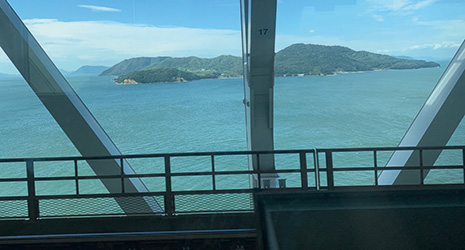
Robins’ snap of the Seto Inland Sea from a train crossing the Seto-Ohashi Bridge in Shikoku 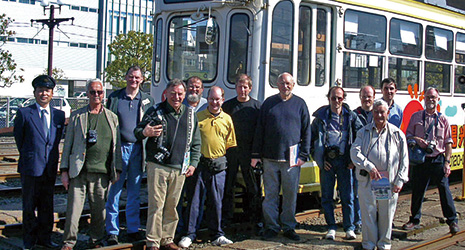
Railway enthusiasts from overseas on a chartered tour of the Okayama Electric Tramway arranged by Robins (second from right)
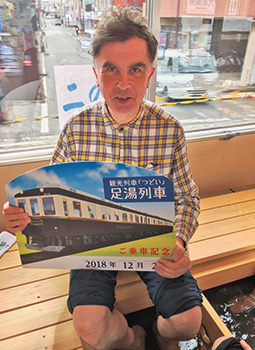
Anthony Robins rides the Kintetsu Railway’s “Tsudoi,” a train equipped with a footbath 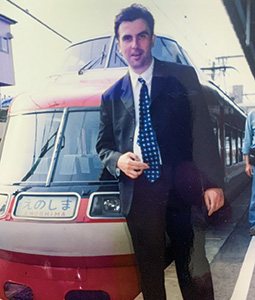
Anthony Robins alongside an Odakyu Electric Railway’s “Romancecar” train sometime in the 1990s 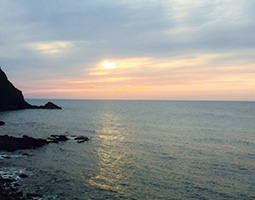
Robins likes to travel the coastal routes. He took this photograph at Omigawa Station in Niigata Prefecture 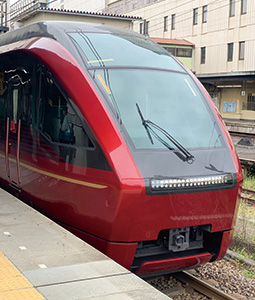
The Kintetsu Railway’s “Hinotori,” one of Robins’ favorite trains 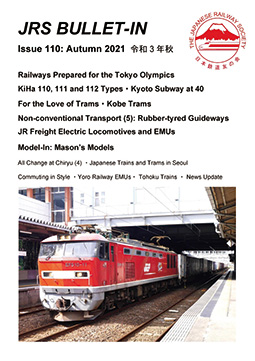
Front cover of a recent issue of the Bullet-In, the newsletter of the Japanese Railway Society edited by Robins and others 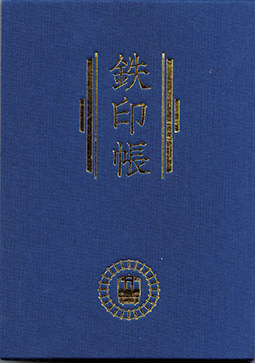
Robins’ “Tetsuincho” railway stamp book

Anthony Robins, originally from England, has been promoting the appeal of Japanese railways for more than thirty years.

Based in the United Kingdom, the birthplace of rail, the Japanese Railway Society (JRS) is a group of railway enthusiasts with an interest in Japanese railways. The society has more than 170 members in countries including the United Kingdom, other European countries, the United States, Australia and Japan. At its peak, the society had as many as 300 members. Anthony Robins, a native of England, has been a member since the society was set up in 1991.
Born in London, Robins says that by age three or four, he already loved railways. “When I was little, I used to pester my mother to take me out on walks to see the trains. Of course, I knew about Japan’s Shinkansen bullet trains from the books I read as a child.” He hoped to get a job in transportation, but the opportunity did not arise. However, Robins did not lose interest in the railways; rather, his interest turned into an all-important and lifelong hobby.

Robins first arrived in Japan in 1983 to start a job teaching English at a school run by a British organization in Tokyo. Later, he returned to the United Kingdom to do a Master’s degree at university. In 1995, he was invited back to Japan to teach English at a university in Japan and ended up making his life here. Since then, he has edited the newsletter for The Japanese Railway Society, reported the latest news about Japan’s railways, and advised on travel itineraries for visiting Society members.

For these tours Robins arranges, he plans interesting itineraries for Japanese railway enthusiasts from overseas that include railway journeys lasting two to three weeks to explore the history and culture of specific regions, including visits to locations such as train depots and rolling stock factories. Although such tours have not been possible during the past two years due to the pandemic, he is now looking forward to restarting the activities.

On the appeal of Japan’s railways, Robins says, “First of all, the accuracy of the Japanese railway timetable is renowned worldwide. The conductors and drivers take pride in their work. It is a really nice feeling to watch them perform the ‘point-and-call.’” He adds, “Another enjoyable thing about the Japanese railways is the rich variety. There’s the Shinkansen, but also the local lines run by regional companies and third-sector operators. Some cities have streetcars, while steam engines run on some routes, although not as many as in the UK.”

The turning of the seasons and a landscape rich in mountains, rivers and other natural features provide another attractive feature of train travel in Japan: the view out the window. Robins likes to travel the coastal routes. “For example, the Nippo Main Line with its majestic views of Sakurajima Island in Kagoshima Prefecture and the sea in Miyazaki Prefecture, or the beautifully silhouetted islands in the Seto Inland Sea seen from the Sanyo Main Line, the Seto-Ohashi Line with its amazing views of the technology for building the bridge, or the Himi Line with its views of the Sea of Japan and the Japan Alps.” Robins reels off one JR Line after another. Though too many to mention, “on private railways, there is stylish and wonderfully comfortable rolling stock, such as Kintetsu Railway and the Odakyu Electric Railway limited express services.”

Yet, “I have still not traveled on every railway line in Japan,” says Robins. “Once I retire from the university and have more time, I want to take some leisurely trips and collect stamps for the ‘Tetsuincho’ railway stamp book published by third-sector railways,” he says.

Japan is a long and narrow archipelago from north to south and the railway system runs its length and breadth, covering a total of 27,000 kilometers. Which routes and what season to choose for travel? During this time of the COVID-19 pandemic, Robins takes great pleasure in thinking over new plans.

